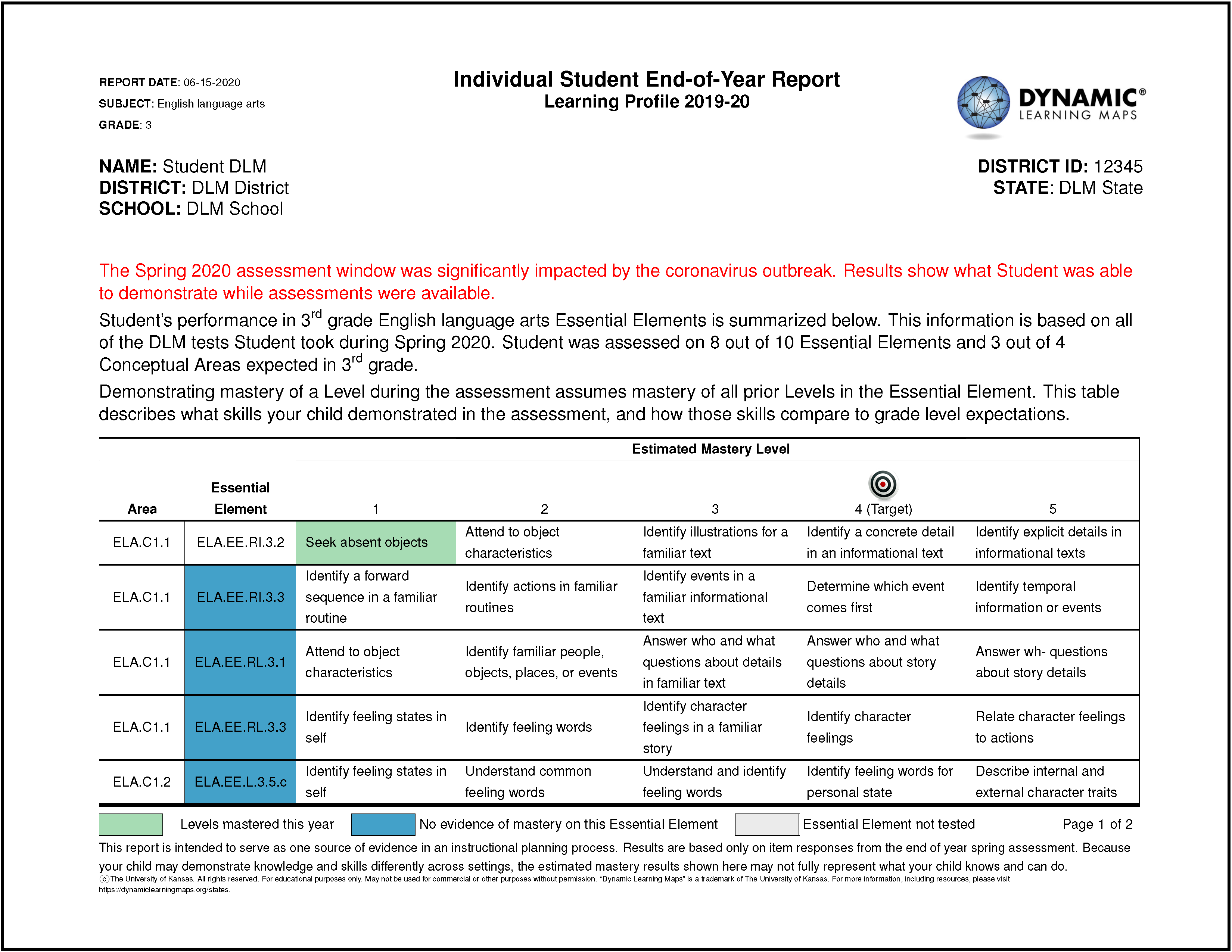7 Assessment Results
Chapter 7 of the Dynamic Learning Maps® (DLM®) Alternate Assessment System 2014–2015 Technical Manual—Year-End Model (Dynamic Learning Maps Consortium, 2016b) describes assessment results for the 2014–2015 academic year, including student participation and performance summaries, and an overview of data files and score reports delivered to state education agencies. Subsequent Technical Manual updates have provided a description of data files, score reports, and results for the corresponding academic year.
Due to the COVID-19 pandemic, the spring 2020 assessment window was significantly impacted. State education agencies made the determination whether to receive data files and reduced score reports following spring 2020. To avoid potential unintended consequences of penalizing students for not being able to complete the full spring window, overall performance level results were not included in the data files delivered to state education agencies. This chapter presents the updates made to the data files and score reports delivered to the state education agencies who opted to receive them. For a complete description of score reports and interpretive guides, see Chapter 7 of the 2014–2015 Technical Manual—Year-End Model (Dynamic Learning Maps Consortium, 2016b).
7.1 Data Files
Data files were made available to six DLM state education agencies who opted to receive them following the spring 2020 administration. The General Research File (GRF) included each student’s highest linkage level mastered for any assessed EE, but did not include a final performance level for the subject. Instead, each student received a new performance level value of 8 to indicate the results were impacted by COVID-19. In addition to the GRF, several supplemental files were delivered to state education agencies. Consistent with prior years, the Special Circumstances File provided information about which students and EEs were affected by extenuating circumstances (e.g., chronic absences), as defined by each state. State education agencies also received a supplemental file to identify exited students. The exited students file included all students who exited at any point during the academic year.
Consistent with prior delivery cycles, state education agencies were provided with a two-week review window following data file delivery to review the files and invalidate student records in the GRF. Decisions about whether to invalidate student records are informed by individual state policy. If changes were made to the GRF, state education agencies submitted final GRFs via Educator Portal. The final GRF was used to generate score reports.
In addition to the GRF and its supplemental files, states who submitted test administration observations were provided with an additional de-identified data file. The test administration observations file provided test administration observation responses with any identifying information removed. For more information about test administration observations, see Chapter 9 of this manual.
7.2 Score Reports
The DLM Consortium provided reduced assessment results to member states who chose to receive them for the spring 2020 administration. Individual Student Score Reports summarized student mastery information for any Essential Elements for which the student was able to demonstrate their knowledge, skills, and understandings. Changes to the Individual Student Score Reports are summarized below. For a complete description of score reports, including aggregated reports, see Chapter 7 of the 2014–2015 Technical Manual—Year-End Model (Dynamic Learning Maps Consortium, 2016b).
7.2.1 Individual Student Score Reports
Due to the reduced spring 2020 assessment window, considerable changes were made to the Individual Student Score Reports for the 2019–2020 year. In prior years, Individual Student Score Reports included a Performance Profile portion which summarized skill mastery for each claim or conceptual area and the performance level for the subject overall. Because overall performance was not provided, a Performance Profile was not generated for the 2019–2020 year.
As described in Chapter 4 of this manual, state education agencies voted to adjust the blueprint to increase the number of items measuring each Essential Element. Because of this change to assessment design, the DLM Consortium was able to support providing the Learning Profile portion of Individual Student Score Reports in 2019–2020. The Learning Profile displays student mastery for any EEs for which the student was assessed. The Learning Profile shows the five linkage levels for each EE: Initial Precursor, Distal Precursor, Proximal Precursor, Target, and Successor. Different colored shading is used to illustrate which skills the student mastered and which Essential Elements were assessed but with no evidence of mastery. The profile also includes a bull’s eye symbol to indicate the Target level is the grade-level expectation. A cautionary statement was added to the 2019–2020 Learning Profile, which indicated that the mastery results show what the student was able to demonstrate during the part of the year assessments were available.
A sample Learning Profile portion of the Individual Student Score Reports reflecting the 2019–2020 changes is provided in Figure 7.1.
Figure 7.1: Example page of the Learning Profile for 2019–2020.

7.3 Quality Control Procedures for Data Files and Score Reports
Changes to the quality control procedures were made only to the extent of accommodating the revised data files and score reports for spring 2020. For a complete description of quality control procedures, see Chapter 7 in the 2014–2015 Technical Manual—Year-End Model (Dynamic Learning Maps Consortium, 2016b) and Chapter 7 in the 2015–2016 Technical Manual Update—Year-End Model (Dynamic Learning Maps Consortium, 2017b).
7.4 Conclusion
Following the spring 2020 administration, state education agencies made the decision whether to receive data files and reduced score reports. Six state education agencies opted to receive GRFs and score reports. States also received a special circumstance code file and an exited students file. A test administration observations file was also made available to states who submitted responses. The GRF assigned a new performance level of 8 to all students, and a statement was added to score reports regarding the impact of COVID-19 on assessment results.